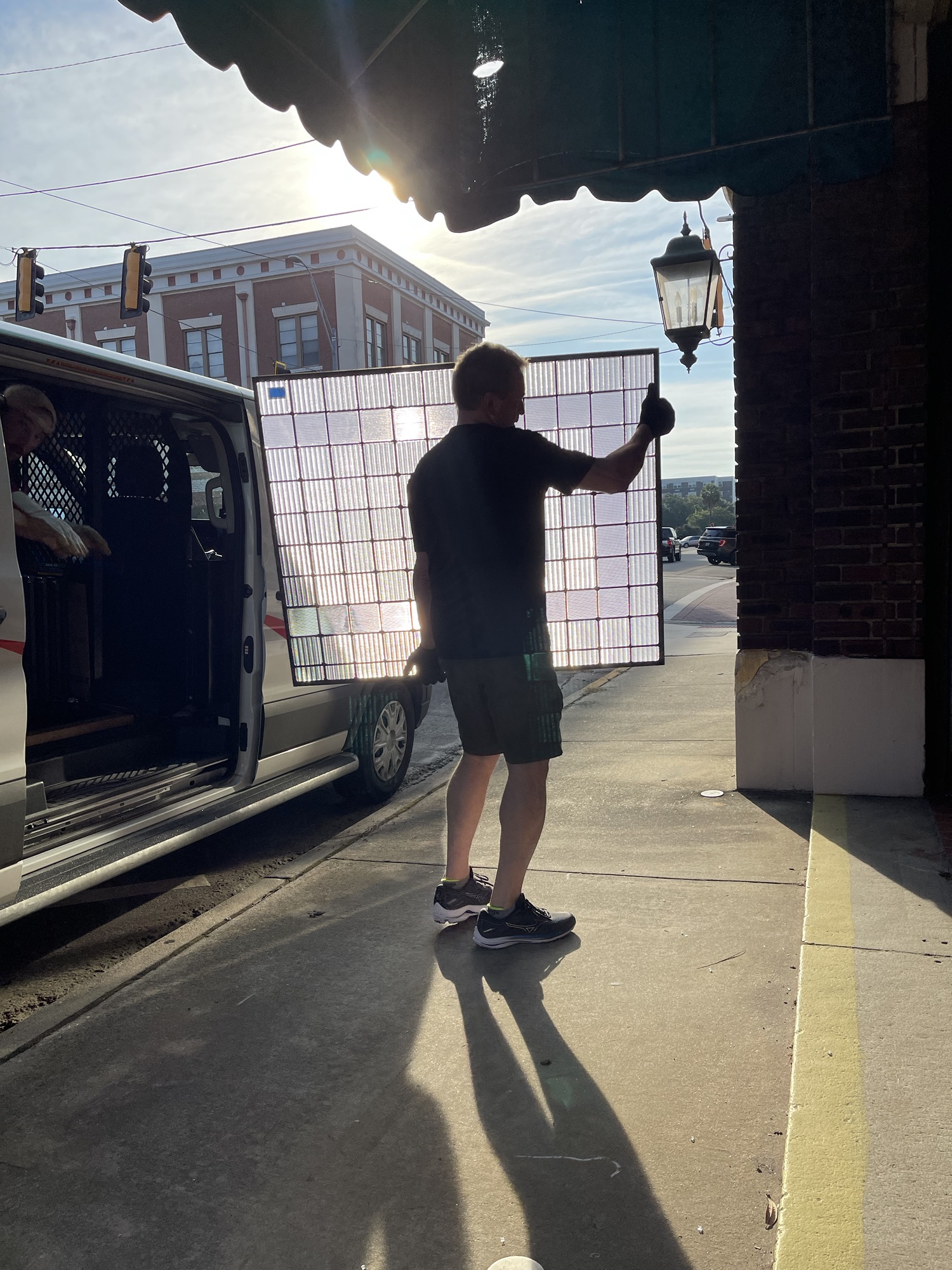
As highlighted in our last blog post, our commitment to preserving the unique prism glass tiles adorning our storefront’s transom windows was of utmost importance and no simple task. These tiles, prevalent in early 1900s architecture, enhanced natural light in these buildings before the advancements of electrical lighting. With the decline in their demand by 1950, production ceased, making their preservation even more vital for our project. In our researching, the importance of maintaining the building’s original charm became even more clear, leading me to choose restoration over the more common, modern approach of using flat or sheet replacement glass for these windows.
The Restoration Challenge

Restoring the transoms was not just about aesthetics; it was a vital safety measure for our community. The glass, in its existing state, was a hazard. Loose and weakened by a century of wear, it was not just a preservation concern but also a potential danger and risk of injury. The urgency of this task became unavoidable when two transoms were accidentally destroyed during the filming of “The White Elephant.” This incident made it evident that addressing the fragile state of these historical elements was not just about saving a piece of history, but also emphasizing the need for a thorough and careful restoration to ensure both the preservation of history and the safety of those around.
Restoration Process

The restoration of each glass tile was a labor of love and precision. Every single piece was meticulously hand-washed in a special cleaning procedure, a process that required delicate handling to not further damage the century-old glass. Then came the careful examination of each tile for structural integrity. The ones that could be saved were reinforced with stronger zinc cames using the same construction that was used in the early 1900s, but that was a much stronger reinforcement than before. This careful blend of preservation and reinforcement ensures that these transoms not only look as they did a century ago but are also strong enough to endure another one hundred years.
The restoration process was entrusted to Keith Oliphant of Glass Restoration Solutions from North Carolina. Keith, who brings a deep passion for historic glass and preservation techniques, was the perfect match for this intricate task. Each tile was gently hand-washed and examined for structural integrity, with Keith’s expertise mapping each window for perfect placement and fittings, and ensuring that the reinstallation of these windows were handled in the utmost care.

This careful blend of preservation and modern reinforcement was essential, and I’m truly grateful for having Keith on board. His dedication and skill were truly vital in bringing these historic transoms back to their former glory.
Sourcing Replacement Tiles

Keith Oliphant faced a significant challenge when he discovered that about 40 of our tiles were not structurally sound for secure placement in the new zinc framing. This led him on a nationwide search for salvaged prism glass tiles, a quest that took him to states like Tennessee, Ohio, Pennsylvania, California, and Montana. Since these tiles are no longer in production, finding replacements was no small feat. This element of our restoration story adds a fascinating layer, incorporating pieces of history from various parts of the U.S. into our building, further enriching its historical story.
Preserving History

Our decision to use original tiles was not driven by historic preservation requirements, but by a commitment to detail and historical accuracy. Using contemporary materials would have compromised the building’s authentic character. These original tiles are more than just components of the structure; they are a connection to its past. Our choice to preserve these elements ensures that the building’s story isn’t just maintained, but vividly told, upholding the integrity of its era and the craftsmanship of a bygone age.
Challenge and Fulfilment

In conclusion, this journey of restoring the prism glass tile transoms has been a blend of challenge and fulfillment. By choosing to preserve these historical treasures, we’ve not only revitalized a key architectural feature but also connected our present with the past. Each tile, sourced from different corners of the country, brings with it a story, enriching our building’s narrative. This project goes beyond mere restoration; it’s a tribute to the craftsmanship of yesteryears and a commitment to honor the legacy embedded in our walls.
























Come on in!
Subscribers receive updates on progress before anyone else. Don't be the last to know, go ahead and sign up!

Wonderful work! Thank you!